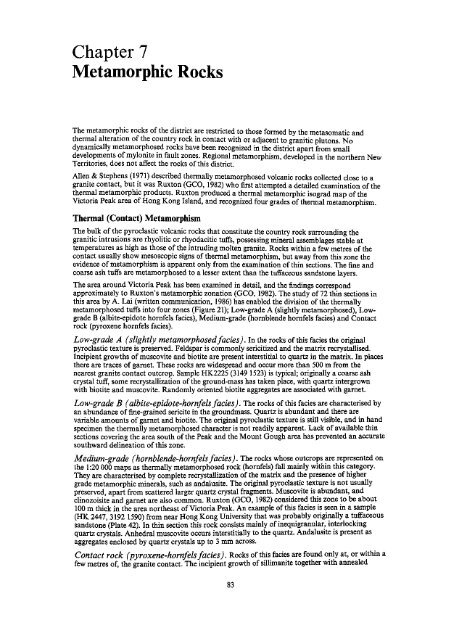Superficial Geology
Superficial Geology
Superficial Geology
You also want an ePaper? Increase the reach of your titles
YUMPU automatically turns print PDFs into web optimized ePapers that Google loves.
Chapter 7<br />
Metamorphic Rocks<br />
The metamorphic rocks of the district are restricted to those formed by the metasomatic and<br />
thermal alteration of the country rock in contact with or adjacent to granitic plutons. No<br />
dynamically metamorphosed rocks have been recognized in the district apart from small<br />
developments of mylonite in fault zones. Regional metamorphism, developed in the northern New<br />
Territories, does not affect the rocks of this district.<br />
Allen & Stephens (1971) described thermally metamorphosed volcanic rocks collected close to a<br />
granite contact, but it was Ruxton (GCO, 1982) who first attempted a detailed examination of the<br />
thermal metamorphic products. Ruxton produced a thermal metamorphic isograd map of the<br />
Victoria Peak area of Hong Kong Island, and recognized four grades of thermal metamorphism.<br />
Thermal (Contact) Metamorphism<br />
The bulk of the pyroclastic volcanic rocks that constitute the country rock surrounding the<br />
granitic intrusions are rhyolitic or rhyodacitic tuffs, possessing mineral assemblages stable at<br />
temperatures as high as those of the intruding molten granite. Rocks within a few metres of the<br />
contact usually show mesoscopic signs of thermal metamorphism, but away from this zone the<br />
evidence of metamorphism is apparent only from the examination of thin sections. The fine and<br />
coarse ash tuffs are metamorphosed to a lesser extent than the tuffaceous sandstone layers.<br />
The area around Victoria Peak has been examined in detail, and the findings correspond<br />
approximately to Ruxton's metamorphic zonation (GCO, 1982). The study of 72 thin sections in<br />
this area by A. Lai (written communication, 1986) has enabled the division of the thermally<br />
metamorphosed tuffs into four zones (Figure 21); Low-grade A (slightly metamorphosed), Lowgrade<br />
B (albite-epidote hornfels fades), Medium-grade (hornblende hornfels facies) and Contact<br />
rock (pyroxene hornfels facies).<br />
Low-grade A (slightly metamorphosed facies). In the rocks of this facies the original<br />
pyroclastic texture is preserved. Feldspar is commonly sericitized and the matrix recrystallised.<br />
Incipient growths of muscovite and biotite are present interstitial to quartz in the matrix. In places<br />
there are traces of garnet. These rocks are widespread and occur more than 500 m from the<br />
nearest granite contact outcrop. Sample HK2225 (3149 1523) is typical; originally a coarse ash<br />
crystal tuff, some recrystallization of the ground-mass has taken place, with quartz intergrown<br />
with biotite and muscovite. Randomly oriented biotite aggregates are associated with garnet.<br />
Low-grade B (albite-epidote-hornfels facies). The rocks of this facies are characterised by<br />
an abundance of fine-grained sericite in the groundmass. Quartz is abundant and there are<br />
variable amounts of garnet and biotite. The original pyroclastic texture is still visible, and in hand<br />
specimen the thermally metamorphosed character is not readily apparent. Lack of available thin<br />
sections covering the area south of the Peak and the Mount Gough area has prevented an accurate<br />
southward delineation of this zone.<br />
Medium-grade (hornblende-hornfels facies). The rocks whose outcrops are represented on<br />
the 1:20 000 maps as thermally metamorphosed rock (hornfels) fall mainly within this category.<br />
They are characterised by complete recrystallization of the matrix and the presence of higher<br />
grade metamorphic minerals, such as andalusite. The original pyroclastic texture is not usually<br />
preserved, apart from scattered larger quartz crystal fragments. Muscovite is abundant, and<br />
clinozoisite and garnet are also common. Ruxton (GCO, 1982) considered this zone to be about<br />
100 m thick in the area northeast of Victoria Peak. An example of this facies is seen in a sample<br />
(HK 2447, 3192 1590) from near Hong Kong University that was probably originally a tuffaceous<br />
sandstone (Plate 42). In thin section this rock consists mainly of inequigranular, interlocking<br />
quartz crystals. Anhedral muscovite occurs interstitially to the quartz. Andalusite is present as<br />
aggregates enclosed by quartz crystals up to 3 mm across.<br />
Contact rock (pyroxene-hornfels facies). Rocks of this facies are found only at, or within a<br />
few metres of, the granite contact. The incipient growth of sillimanite together with annealed<br />
83

















